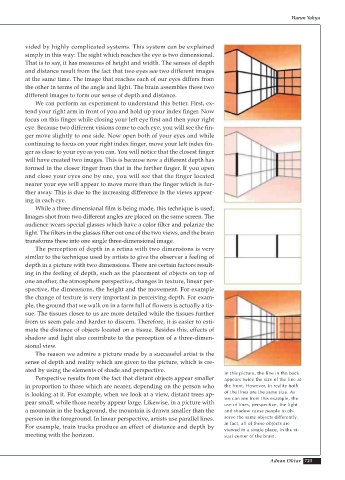Page 723 - Atlas of Creation Volume 3
P. 723
Harun Yahya
vided by highly complicated systems. This system can be explained
simply in this way: The sight which reaches the eye is two dimensional.
That is to say, it has measures of height and width. The senses of depth
and distance result from the fact that two eyes see two different images
at the same time. The image that reaches each of our eyes differs from
the other in terms of the angle and light. The brain assembles these two
different images to form our sense of depth and distance.
We can perform an experiment to understand this better. First, ex-
tend your right arm in front of you and hold up your index finger. Now
focus on this finger while closing your left eye first and then your right
eye. Because two different visions come to each eye, you will see the fin-
ger move slightly to one side. Now open both of your eyes and while
continuing to focus on your right index finger, move your left index fin-
ger as close to your eye as you can. You will notice that the closest finger
will have created two images. This is because now a different depth has
formed in the closer finger from that in the farther finger. If you open
and close your eyes one by one, you will see that the finger located
nearer your eye will appear to move more than the finger which is fur-
ther away. This is due to the increasing difference in the views appear-
ing in each eye.
While a three dimensional film is being made, this technique is used;
Images shot from two different angles are placed on the same screen. The
audience wears special glasses which have a color filter and polarize the
light. The filters in the glasses filter out one of the two views, and the brain
transforms these into one single three-dimensional image.
The perception of depth in a retina with two dimensions is very
similar to the technique used by artists to give the observer a feeling of
depth in a picture with two dimensions. There are certain factors result-
ing in the feeling of depth, such as the placement of objects on top of
one another, the atmosphere perspective, changes in texture, linear per-
spective, the dimensions, the height and the movement. For example
the change of texture is very important in perceiving depth. For exam-
ple, the ground that we walk on in a farm full of flowers is actually a tis-
sue. The tissues closer to us are more detailed while the tissues further
from us seem pale and harder to discern. Therefore, it is easier to esti-
mate the distance of objects located on a tissue. Besides this, effects of
shadow and light also contribute to the perception of a three-dimen-
sional view.
The reason we admire a picture made by a successful artist is the
sense of depth and reality which are given to the picture, which is cre-
ated by using the elements of shade and perspective.
In this picture, the line in the back
Perspective results from the fact that distant objects appear smaller appears twice the size of the line at
in proportion to those which are nearer, depending on the person who the front. However, in reality both
of the lines are the same size. As
is looking at it. For example, when we look at a view, distant trees ap-
we can see from this example, the
pear small, while those nearby appear large. Likewise, in a picture with use of lines, perspective, the light
a mountain in the background, the mountain is drawn smaller than the and shadow cause people to ob-
person in the foreground. In linear perspective, artists use parallel lines. serve the same objects differently.
In fact, all of these objects are
For example, train tracks produce an effect of distance and depth by
viewed in a single place, in the vi-
meeting with the horizon. sual center of the brain.
Adnan Oktar 721

